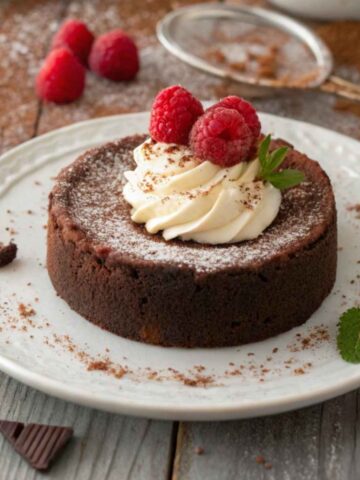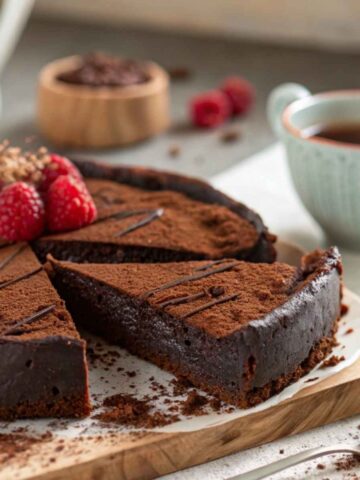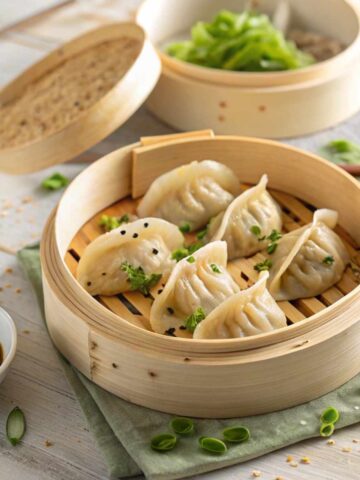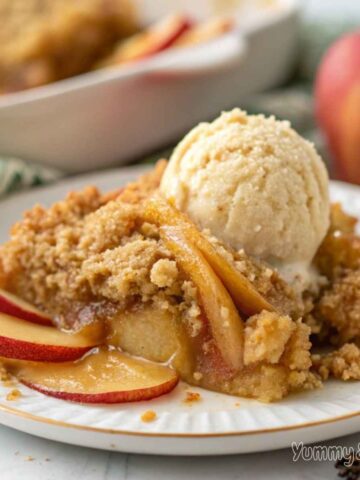There's nothing like freshly baked biscuits wafting through the kitchen, right? Biscuits are a beloved comfort food flaky, buttery, and versatile. But for those avoiding gluten, finding a perfect biscuit can feel like a challenge. Gluten free biscuits have gained popularity recently, but can they deliver that same fluffy, tender bite as their gluten-filled counterparts?

The short answer: yes! With the right ingredients and techniques, gf biscuits can be just as delicious as traditional ones. In this article, we’ll guide you through gluten free biscuits by exploring ingredients, tips, and techniques. Furthermore, we will ensure you achieve biscuit perfection, whether you are baking from scratch or opting for store bought versions.
Jump to:
- What Is Gluten, and Why Do Some People Avoid It?
- What Are Gluten-Free Biscuits?
- Common Gluten-Free Flours for Biscuits
- How Gluten-Free Flours Affect Biscuit Texture
- The Importance of Xanthan Gum and Psyllium Husk
- How to Make Gluten-Free Biscuits from Scratch
- Store-Bought Gluten-Free Biscuits: Are They Worth It?
- Dairy-Free and Vegan Options for Gluten-Free Biscuits
- Common Problems When Making Gluten-Free Biscuits (and How to Fix Them)
- Gluten-Free Biscuit Recipe Variations
- Nutritional Value of Gluten-Free Biscuits
- Can People with Celiac Disease Eat Gluten Free Biscuits Safely?
- Gluten-free biscuits for Special Occasions
- Conclusion
- FAQs
- Gluten-Free Biscuits
What Is Gluten, and Why Do Some People Avoid It?
Understanding Gluten and Its Role in Baking
Gluten is a protein found in wheat, barley, and rye. It’s what gives dough its structure and elasticity. In baked goods like bread, cakes, and biscuits, gluten helps to trap air bubbles, giving them that light, fluffy texture. But when you remove gluten from the equation, it can be challenging to recreate that same texture in gluten free recipes.
Celiac Disease and Gluten Sensitivity: Why Gluten Matters
For people with celiac disease or gluten sensitivity, avoiding gluten isn’t just a lifestyle choice—it’s essential for their health. Celiac disease is an autoimmune disorder where consuming gluten causes damage to the small intestine, leading to a host of health issues. Even for those without celiac, gluten sensitivity can cause uncomfortable symptoms like bloating, headaches, and fatigue.
What Are Gluten-Free Biscuits?
Used Ingredients
GF biscuits are made using flours that don’t contain gluten. This can include a variety of gluten free grains, starches, and nut based flours. Some common ingredients in gluten free biscuits are rice flour, almond flour, tapioca starch, and potato starch. To replace gluten’s binding power, ingredients like xanthan gum or psyllium husk are often added.
Critical Differences Between Regular and Gluten-Free Biscuits
The main difference between gluten free and regular biscuits is texture. Without gluten, GF biscuits can be more crumbly or dense. Without gluten, gluten free biscuits can be more crumbly or dense. However, with the proper techniques, you can still achieve that light, flaky texture. Additionally, GF biscuits may have a slightly different flavor, especially if you’re using nut-based flours like almond flour.
Common Gluten-Free Flours for Biscuits
If you’re planning to bake biscuits at home, it's crucial to understand the types of flour you can use. Different flours offer different textures, flavors, and nutritional benefits.
1 Almond Flour: A Nutty, Moist Option
Almond flour is made from finely ground almonds, adding a rich, slightly nutty flavor to biscuits. It’s also high in healthy fats, which help keep your biscuits moist.
2 Rice Flour: Light and Neutral
Rice flour is one of the most common flours used in gluten-free baking. It’s light and neutral in flavor, making it an excellent base for biscuits. However, it can be a bit gritty; therefore, it is often combined with other starches to improve the texture.
3 Coconut Flour: A Low-Carb Alternative
Coconut flour is a good option for those watching their carbs. It absorbs a significant amount of moisture; therefore, you must adjust the liquid in your recipe accordingly. The result is a denser, more crumbly biscuit with a slightly sweet coconut flavor.
4 Sorghum Flour: Whole Grain Benefits
Sorghum flour is a whole grain flour that adds a slightly sweet, nutty flavor. It’s rich in fiber and protein, making it a nutritious choice.
How Gluten-Free Flours Affect Biscuit Texture
The Challenge of Replacing Gluten's Elasticity
Gluten is what gives traditional biscuits their structure and elasticity. Without it, gluten free biscuits can be dense or fall apart quickly. That’s why most gluten free biscuit recipes call for a combination of flours and starches to mimic the effects of gluten.
Achieving a Light and Flaky Biscuit Without Gluten
The key to achieving that classic biscuit texture is using the right combination of flours and aeration techniques. This means mixing your dough gently and, moreover, using cold fat (like butter or shortening) to create pockets of air that will expand during baking, resulting in a light and flaky texture for your biscuits.
The Importance of Xanthan Gum and Psyllium Husk
Binding Ingredients That Mimic Gluten
Without gluten, you need something to bind your ingredients together. That’s where xanthan gum and psyllium husk come in. Xanthan gum is a standard gluten free binder that helps dough hold together and rise. Psyllium husk, on the other hand, is a plant-based fiber that can add structure to your biscuits.
How to Use Xanthan Gum and Psyllium Husk in Biscuits
For GF biscuits, you’ll only need a small amount of xanthan gum or psyllium husk—usually about 1/4 to 1/2 teaspoon per cup of flour. This will help give your biscuits that familiar chewy texture and prevent them from falling apart.
How to Make Gluten-Free Biscuits from Scratch
Step-by-Step Recipe for Perfect Gluten-Free Biscuits
Ready to make your biscuits from scratch? Here’s a simple recipe to give you perfect biscuits every time.
Ingredients:
- 2 cups of gluten-free all-purpose flour
- One tablespoon of baking powder
- 1/2 teaspoon of xanthan gum (if not included in your flour blend)
- 1/2 teaspoon of salt
- Six tablespoons of cold butter (or dairy-free alternative)
- 3/4 cup of buttermilk (or dairy-free milk with one tablespoon of lemon juice)
Instructions:
- Preheat your oven to 425 °F (220°C). Line a baking sheet with parchment paper.
- Whisk together the gluten-free flour, baking powder, xanthan gum (if using), and salt in a large mixing bowl.
- Cut the cold butter into small cubes and add it to the flour mixture. Use a pastry cutter or your hands to cut the butter into the flour until the mixture resembles coarse crumbs. The butter should still be in small, pea-sized chunks.
- Slowly add the buttermilk, stirring gently with a fork until the dough just comes together. Be careful not to overmix, as this can make the biscuits tough.
- Turn the dough onto a lightly floured surface (using gluten-free flour). Pat it into a 1-inch thick rectangle. Use a biscuit cutter or the rim of a glass to cut out biscuits. Press straight down without twisting to ensure the biscuits rise evenly.
- Place the biscuits onto the prepared baking sheet, making sure they are close together (this helps them rise). Brush the tops with a little melted butter if desired.
- Bake for 12-15 minutes until the biscuits are golden brown and flaky. Serve warm with butter, honey, or your favorite toppings.
Tips for Achieving a Flaky, Buttery Texture
- Keep your butter cold. Cold butter creates steam as it melts in the oven, helping to create those flaky layers.
- Don't overmix the dough: Overworking the dough can cause the biscuits to become dense. Mix just until the ingredients come together.
- Use a sharp cutter: When cutting the biscuits, press straight down without twisting. Twisting can seal the edges and prevent the biscuits from rising properly.
Store-Bought Gluten-Free Biscuits: Are They Worth It?
Sometimes, you just don’t have time to make biscuits from scratch, and that’s okay. Luckily, there are several store-bought gluten-free biscuits available. But are they worth the convenience?
Review of Popular Brands
Here are some of the top brands offering gluten-free biscuits:
Glutino GF Biscuits: Known for their tender, crumbly texture, these biscuits are a popular choice for gluten-free eaters.
Udi’s Gluten-Free Dinner Rolls: While technically not biscuits, these rolls offer a soft and fluffy alternative to traditional biscuits. Moreover, they are an excellent option for dinners or holiday meals, especially when you need a quick and reliable gluten-free choice.
Schar GF Biscuits: Schar is known for its wide range of gluten-free products, and its biscuits are no exception. They’re often praised for their similar texture to traditional biscuits.
Pros and Cons of Ready-Made Gluten-Free Biscuits
Pros:
Convenience: Ready in minutes, no need for mixing or rolling.
Consistency: Store-bought biscuits tend to have a consistent texture.
Variety: Many brands offer different flavors or variations, such as cheddar or herb-infused biscuits.
Cons:
Texture: Store-bought biscuits may not have the same homemade flakiness.
Cost: Gluten-free products are often more expensive than their gluten-containing counterparts.
Ingredients: Some store-bought biscuits contain preservatives or other additives you might want to avoid.
Dairy-Free and Vegan Options for Gluten-Free Biscuits
Substituting Butter and Milk in Gluten-Free Recipes
If you’re avoiding dairy and gluten, don’t worry GF biscuits can still be delicious without butter or milk. Coconut oil or dairy-free margarine can be used instead of butter. In contrast, almond, coconut, or oat milk can replace traditional dairy.
Vegan-Friendly Ingredients to Use
You’ll want to use non-dairy milk and replace the butter with a plant-based alternative for vegan biscuits. If the recipe calls for eggs, you can use flax eggs (1 tablespoon ground flaxseed mixed with three tablespoons water) as an egg substitute.
Common Problems When Making Gluten-Free Biscuits (and How to Fix Them)
Why Are My Biscuits Crumbly?
One common issue when making gluten-free biscuits is that they can become crumbly. This usually happens because gluten-free flours lack the elasticity of gluten. Add a binding agent like xanthan gum or psyllium husk to your dough to fix this. You can also increase the fat content by adding more butter or a bit of oil to help hold the biscuits together.
How to Get a Better Rise in Gluten-Free Biscuits
Getting a good rise in gluten free biscuits can be tricky. To improve the increase, ensure your oven is fully preheated and use fresh baking powder. Cold butter also helps create steam pockets, aiding the rising process. And remember, don’t overmix your dough—this can make your biscuits denser.
Gluten-Free Biscuit Recipe Variations
Are you looking to mix things up? Here are a few variations on the classic gluten free biscuit recipe.
1 Cheddar Cheese Biscuits
For a savory twist, add sharp cheddar cheese to your biscuit dough. Simply add 1 cup of grated cheddar cheese before cutting out your biscuits. You can add a pinch of garlic powder or herbs for extra flavor.
2 Herb and Garlic Biscuits
Herb-infused biscuits are perfect for serving with dinner. Add one tablespoon of finely chopped fresh herbs like rosemary, thyme, or parsley and a teaspoon of garlic powder to your dough. These biscuits pair beautifully with soups and stews.
3 Sweet Gluten-Free Biscuits
For a sweeter version, increase the sugar in the dough to 2-3 tablespoons and add a splash of vanilla extract. These sweet biscuits are perfect for serving with strawberries and whipped cream for a gluten-free shortcake.
Nutritional Value of Gluten-Free Biscuits
Calories and Nutrients in Common Gluten-Free Biscuits
GF biscuits vary in nutritional content depending on the flour and ingredients used. On average, a standard gluten free biscuit contains around 100-150 calories per serving. Almond flour or coconut flour can boost the fiber and healthy fat content, while rice flour tends to be lower in nutrients.
Comparing Gluten-Free and Regular Biscuits
Compared to traditional biscuits made with wheat flour, GF biscuits tend to be lower in protein and fiber unless you use whole-grain flour like sorghum or buckwheat. However, GF biscuits can be more nutrient-dense if made with nut flours like almond flour, which is high in protein and healthy fats.
Can People with Celiac Disease Eat Gluten Free Biscuits Safely?
The Importance of Certified Gluten-Free Labels
For individuals with celiac disease, it’s crucial to ensure that the biscuits you’re eating are certified gluten-free. This certification means that the product has been tested and contains less than 20 parts per million (ppm) of gluten, which is considered safe for most people with celiac disease.
Avoiding Cross-Contamination at Home
Even if a product is labeled gluten-free, cross contamination can occur in your kitchen. To avoid accidental contamination, keep your gluten free flours and baking tools separate from gluten containing ingredients. Use dedicated utensils and baking pans for gluten-free recipes.
Gluten-free biscuits for Special Occasions
Holiday and Celebration Biscuit Recipes
Gluten-free biscuits aren’t just for everyday meals—they can also be the star of your holiday celebrations. For Thanksgiving, try making GF buttermilk biscuits to serve alongside your turkey. You could whip up a batch of gluten free gingerbread biscuits for Christmas with festive spices like cinnamon, nutmeg, and cloves.
How to Make Gluten-Free Biscuits a Family Tradition
Get the whole family involved in making gluten free biscuits! This is a fun way to introduce kids to gluten free cooking and create lasting family traditions. You can make a batch of biscuits together for special weekend breakfasts or brunches.
Conclusion
GF biscuits can be just as tasty and satisfying as their gluten filled counterparts. With the right combination of flours, techniques, and helpful tips, you can bake flaky, tender biscuits that will impress even the most die-hard gluten lovers.
Whether making them from scratch or buying store-bought varieties, gluten free biscuits are a delicious and versatile addition to your gluten free kitchen. So, don’t be afraid to experiment with different flours, flavors, and add-ins. After all, baking is about finding what works best for you—and having fun while doing it!
FAQs
The best GF flour for biscuits depends on your preference. A blend of rice flour, tapioca starch, and potato starch works well, but for a more nutrient-dense option, try using almond flour or sorghum flour.
Many store-bought gluten free flour blends are designed to work as a 1:1 replacement for regular flour in most recipes. Look for a blend that includes xanthan gum, or add a little yourself.
GF biscuits can taste just as delicious as regular biscuits, although the texture may differ slightly. With the right recipe, you can achieve a light, flaky biscuit that is hard to tell apart from the traditional version.
To prevent crumbliness, use a good binding agent like xanthan gum or psyllium husk. Adding more fat, such as butter or oil, can also help keep the biscuits moist and less crumbly.
Yes it can be healthier if made with nutrient-dense flours like almond or sorghum flour. However, some gluten free products can be higher in sugar or fats, so checking the nutritional information is essential.

Gluten-Free Biscuits
- Total Time: 30 minutes
- Yield: 8 biscuits 1x
Description
These gluten-free biscuits are light, flaky, and perfect for any meal. Whether paired with butter, jam, or served as a side dish, they are a delightful treat for everyone!
Ingredients
- 2 cups gluten-free all-purpose flour
- 1 tablespoon baking powder
- 1/2 teaspoon xanthan gum (if not included in your flour blend)
- 1/2 teaspoon salt
- 6 tablespoons cold butter (or dairy-free alternative)
- 3/4 cup buttermilk (or dairy-free milk with 1 tablespoon lemon juice)
Instructions
- Preheat your oven to 425°F (220°C). Line a baking sheet with parchment paper.
- In a large bowl, whisk together the gluten-free flour, baking powder, xanthan gum (if using), and salt.
- Cut the cold butter into small cubes and add it to the flour mixture. Use a pastry cutter or your hands to mix until the mixture resembles coarse crumbs.
- Gradually stir in the buttermilk with a fork until the dough comes together. Avoid overmixing.
- Turn the dough onto a lightly floured surface and pat it into a 1-inch thick rectangle.
- Use a biscuit cutter or the rim of a glass to cut out biscuits, pressing straight down without twisting.
- Place biscuits on the prepared baking sheet, close together to help them rise. Brush the tops with melted butter if desired.
- Bake for 12-15 minutes or until golden brown. Serve warm with your favorite toppings.
Notes
- For a dairy-free version, substitute butter with coconut oil and buttermilk with almond or oat milk.
- To achieve the best rise, ensure your butter is cold and your oven is fully preheated.
- Prep Time: 15 minutes
- Cook Time: 15 minutes
- Category: Side Dish
- Cuisine: American
Nutrition
- Calories: 120
Keywords: Easy Gluten-Free Recipes, Flaky Biscuits, gluten-free baking, Gluten-Free Biscuits





Leave a Reply